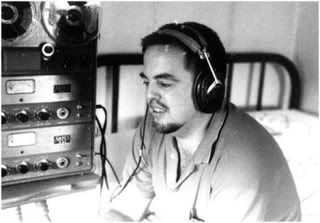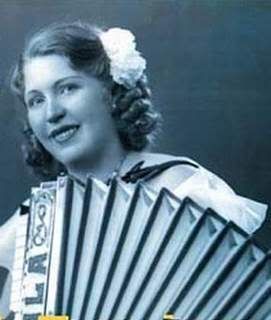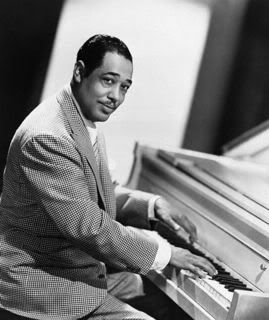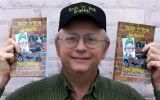
Alan Lomax
By STEVE SEYMOUR
An important part of the Upper Peninsula's cultural heritage isn't getting the attention it deserves.
Music recordings made by U. P. artists get an occasional mention, but have generally been ignored for decades.
Our "ah-shucks" practice of overlooking this self-made music isn't helping preserve it, either.
In fact, sometimes our regional music gets so little recognition, even the area's residents aren't aware of it.
Sent by the Library of Congress, early musicologist Alan Lomax was quite eager to save the U. P.'s rich music heritage, even in the late 1930s. During just four months in northern Michigan, he recorded nearly 1,000 folk songs, from singers with Finnish, Irish and French backgrounds.
Viola Turpeinen
Although Lomax was gathering material which reflected the folk influences of the region's often-isolated immigrants, he certainly ran across the considerable reputation of Viola Turpeinen. Born near Champion in 1909, Turpeinen was a major star in the Finnish-American community.
A master of the accordion and a fine vocalist, Turpeinen recorded dozens of popular polka and waltz records. She toured extensively, but her career was cut short when she died from cancer in 1958.
By the 1950s, however, another squeezebox master was making his presence felt in the jazz world. Art VanDamme, born in the small community of Norway, eventually recorded at least a dozen noteworthy albums. He has played with Dizzy Gillespie, Buddy DeFranco, Ella Fitzgerald and Peggy Lee.
While his cool sound was an integral part of the post-bop sound of the 1960s, VanDamme isn't the only connection between jazz and the Upper Peninsula. In 1959, Duke Ellington traveled to Marquette to participate in the making of "Anatomy of a Murder," written by Ishpeming's John Voelker.
Duke Ellington
Ellington, who also had a bit part in Otto's Preminger's production, composed the soundtrack in the Upper Peninsula while the movie was being shot. With Ellington's songs, "Anatomy" became one of the first major motion pictures to feature a jazz soundtrack.
As "Anatomy" earned its reputation as a great movie, rock 'n' roll music began to dominate. Young men created their own groups hoping to duplicate the success they saw bands having on Dick Clark's "American Bandstand" or the Ed Sullivan Show.
This "garage band" explosion happened across the country, but myriad groups were also created in the remote counties of northern Michigan. Communities from Ironwood on the west to Sault Ste. Marie on the east, and virtually every place between, had rock bands hoping to make it to the big time. Many of these bands didn't just play, they made records, too.
Some of the biggest U. P. bands during this period were Ironwood's Galaxies, Marquette's Excels, Houghton's Kinetics, Sault Ste. Marie's Renaissance Fair, and the Rhythm Rockers and Vigilantes from the Copper Country. These groups, and others like them, issued scores of worthwhile 45 rpm records during the 1960s. Many of these singles sold in quantities of less than 1,000 copies and are hard to find today.
Country acts from northern Michigan also took aim at the top of the music business, the most notable being Lane Dawson and the Dawson Boys from Ishpeming. They recorded numerous 45s. In addition, local rivals, the Ramblers, added several singles of their own.
In fact, one of Dawson's musical cohorts was Jim DeCaire, founder of Da Yoopers. Certainly, the U. P.'s best known group, Da Yoopers have been recording since 1985, much to the delight of anyone with a sense of humor.
Da Yoopers have been successful getting airplay for their tunes all over the country. Sure, their songs poked a little fun at the locals, but the spotlight gave some new attention to the Upper Peninsula.
With the arrival digital technology, more and more U. P.-based acts have been able to record, manufacture and distribute their music. That's because computers copy and store music with ease, although the compact disc doesn't carry the same mystique that records once did.
At one time almost every home had a record changer. Now, most phonographs are in disrepair or have been junked. Often record collections follow those antiquated machines to the landfill.
Consequently, music which doesn't get transferred to digital carries the risk of being lost in the modern age.
I purchased the first U. P. records in my collection in 1968 when I bought 45 rpm singles from two Escanaba bands, the Riot Squad and the Prophets of Doom. I picked up other regional records when I ran across them.
Some of the first LP's I added were "The Wayfarers...Live," which featured my childhood friend Bill VanEffen, and "Up With People," the album recorded on Mackinac Island which included Glenn Close, before she went into acting.
Since entering the retail record business almost a quarter century ago, I've been able to add a considerable number of U. P.-related records to my accumulation. Occasionally, I still learn about pre-compact disc era LPs and 45s I didn't know about.
My U. P. stash ranges from rock to country, polka to easy listening, jazz to comedy. Even rockabilly and gospel styles are represented.
I've transferred many of those U. P.-related recordings to digital. Call it the beginning of an Upper Peninsula music archive, if you will.
In our rush into the future, we should be careful not to destroy the irreplaceable recordings which have contributed to the U. P.'s diverse cultural heritage, whether on purpose or by neglect.


 I've enjoyed rock music and writing since I was a teenager in the 60s. I feel lucky to have been around when rock's greatest stars created their most enduring hits. At the same time I found I enjoyed writing, as well. I worked on my high school newspaper and magazine, was editor of several college publications and earned a bachelor's degree from Central Michigan University in 1973. I worked for the daily newspaper in my hometown after graduating, becoming managing editor after a few years. By the 1980s, I moved into public relations. In 1985, my wife Sue and I opened a retail music store, The Record Rack, which we still own. Rock 'n' roll has been integral to me and for the last 2O years I've been earning my living from it even though I don't have a musical bone in my body. In recent years, I've also I edited a small local magazine and launched a micro FM radio station. Now, I'm finally combining my love of writing and rock 'n' roll. I can't sing a note, but I know what I like. I'll tell you all about it when you read on. I hope you have as much enjoyment reading these installments as I've had writing them.
I've enjoyed rock music and writing since I was a teenager in the 60s. I feel lucky to have been around when rock's greatest stars created their most enduring hits. At the same time I found I enjoyed writing, as well. I worked on my high school newspaper and magazine, was editor of several college publications and earned a bachelor's degree from Central Michigan University in 1973. I worked for the daily newspaper in my hometown after graduating, becoming managing editor after a few years. By the 1980s, I moved into public relations. In 1985, my wife Sue and I opened a retail music store, The Record Rack, which we still own. Rock 'n' roll has been integral to me and for the last 2O years I've been earning my living from it even though I don't have a musical bone in my body. In recent years, I've also I edited a small local magazine and launched a micro FM radio station. Now, I'm finally combining my love of writing and rock 'n' roll. I can't sing a note, but I know what I like. I'll tell you all about it when you read on. I hope you have as much enjoyment reading these installments as I've had writing them.


No comments:
Post a Comment